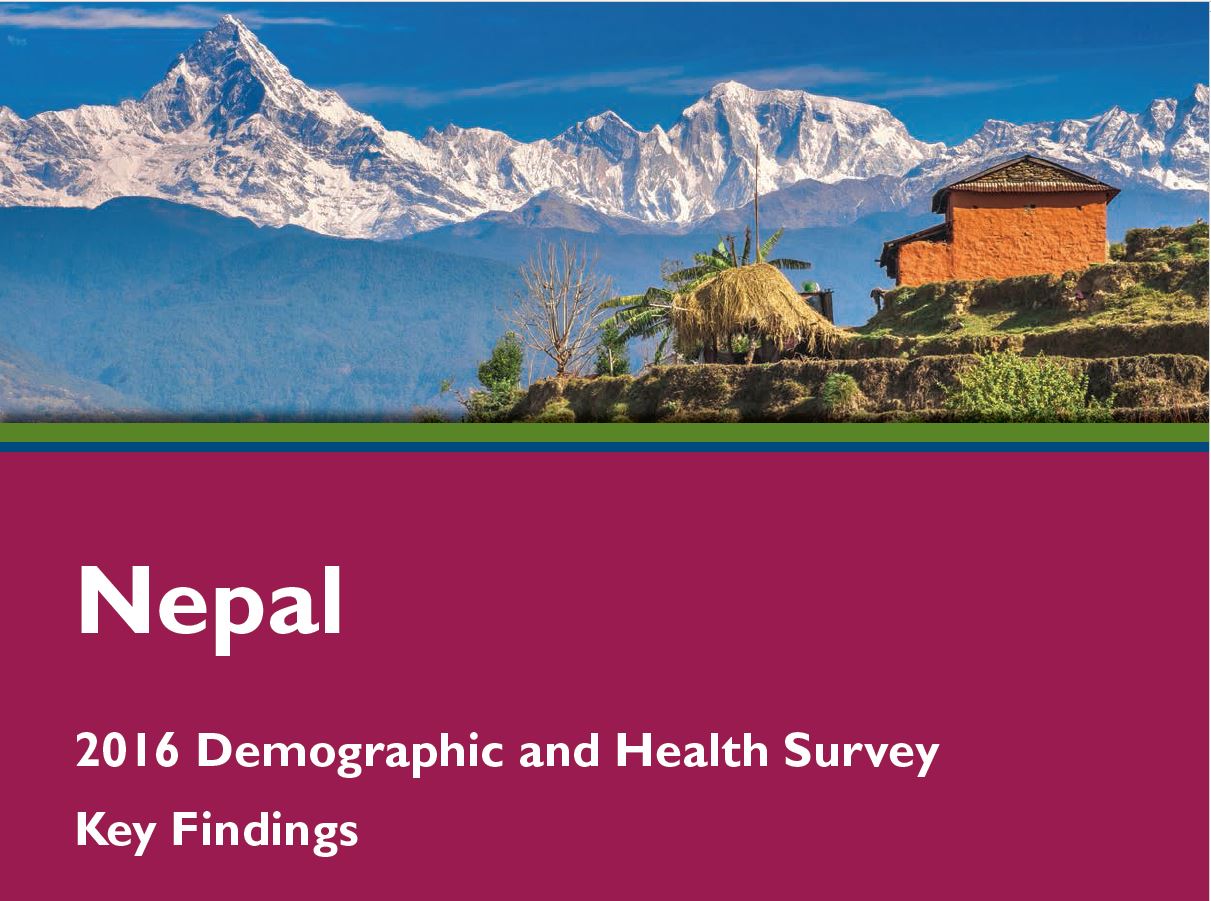NDHS (National Demographic and health survey, 2016) was done under the guidance of then Ministry of Health of Nepal. It was carried out by New ERA from 19th June, 2016 to 31st January, 2017.
Every five years, Ministry of Health and Population surveys about the health and population situation in its country. The survey was first started in 1996.

Data included in NDHS 2016
This session of national survey has delved into the following details. 2,862 women age 15-49 in 11,040 surveyed households and 4,063 men
age 15-49 in half of the surveyed households were interviewed.
- fertility levels and preferences
- marriage
- sexual activity
- family planning methods
- breastfeeding practices
- nutrition
- anemia
- childhood and maternal mortality
- maternal and child health
- HIV/AIDS and other Sexually transmitted infections (STIs)
- women empowerment and
- hypertension
Salient findings of NDHS 2016
- Average household size: 4.2 members. Women lead about 31% of families. Thirty four percent of population is under age 15.
- About 95% have access to safe and clean drinking water
- Improvised sanitation is present in about 62% of the households
- Electricity is present in 94% of urban households and 85% of rural households
- Migration is rampant with values about forty seven percentage (47%). Eighty percent men migrated for work. Migration in 67% female is due to marriage. External migration is common in men and less common in women. The most common destination for male migration is Middle east followed by India.
- In Nepal, thirty three percent (33%) females are uneducated in comparison to only 10% male who are uneducated. As per NDHS, 69% women and 89% men are literate.
- 52% Nepalese have television while 93% own a telephone.
- The total fertility rate of Nepal is s 2.3. In 1996 it was 4.6
- Age at first marriage: The median age at first marriage for women age 25- 49 is 17.9 years, compared to 21.7 years among men age 25-49. About 52% women marry before age 18 compared to 19% of their male counterparts.
- Age at first sex: For female it is the same as their marriage age while for male it is 20.5 years of age.
- Teenage Pregnancy in Nepal: About 17% females are pregnant with their first child within age 15-19 years.
- Contraceptive Prevalence Rate of Nepal is 52.6% combining both modern and traditional methods.
- The total demand for family planning among married women in Nepal is 76%. However, the met need is only 52.6% (equivalent to CPR) and the remaining is unmet. Adequate number of both male and female have seen some form of family planning advertisements in various modes of communication.
- About 97 percent married men and 68 percent married women are employed in Nepal.
- The prevalence of domestic violence is about 22 percent in Nepal.
- In Nepal, the prevalence of hypertension is in 17% of women and 23% of men.

Mortaility Trends as per NDHS 2016
- The infant mortality rate of Nepal in 2016 is 32 per 1000 live births.
- The childhood mortality rate in 2016 is 39 per 1000 live births.
- The neonatal mortality rate in 2016 is 21 deaths per 1000 live births. Hence the government of Nepal is focusing much of its preventive health programs in lowering this rate. A distinctive example of this is incorporation of neonatal care in Integrated management of Neonatal and Childhood Illness (IMNCI) program.
- Median Birth Interval in Nepal is 36 months. Birth spacing for less than 2 years may predispose to a high childhood mortality rate upto 78 per 1000 live births, cites the study. However, more than 21% children are spaced for about two years only.
Maternal and childhood indices as per NDHS 2016
- In Nepal, 84% of women receive antenatal care (ANC) from a skilled service provider
- About 67 percent women take their first ANC visit within the first trimester.
- Similarly, 70 percent women make four or more ANC visits.
- The skilled birth attendance (SBA) has increased from 9 percent in 1996 to 58% in 2016. Most of these deliveries occur at government health facilities. However, the aim of government is to increase SBA up to 85 percent.
- The maternal mortality ratio (MMR) for Nepal is 239 deaths per 100,000 live births ( Confidence Interval : 134 – 345)
- About 78% children have received vaccinations as per the extended program of immunization (EPI) of Nepal.
- Among childhood illness, fever is present in about 20 percent, diarrhea in 8 percent and acute respiratory infection (ARI) in 2 percent.
- Almost all of the children are breast fed. About 55 percent of all newborns were breast fed in the first hour of birth. Thirty percent of newborn are fed with lactation supplements instead of breast milk in the few initial hours after birth.
- Exclusive breast feeding is done for an average period of 4.3 months, according to the survey.
- Use of iodized salt is the most common method of preventing iodine deficiency in Nepal.
- About 60 percent women take iron in pregnancy for a period of about 6 months.
- More than half (53%) of children age 6-59 months are anemic
Prevalence of malnutrition in Nepal
According to the NDHS survey, about 36 percent of children in Nepal are stunted (low height for age). The prevalence of wasting (low weight for height) is ten percent. Hence acute malnutrition in Nepal is also 10%. About 22 percent of women are overweight or obese in comparison to 17 percent men. Forty percent women, aged 15-49 in Nepal are anemic.
Pregnancy outcomes in Nepal
As per NDHS 2016, 81% are live births, 9% are miscarriages, 9% are
abortions, and 1% are stillbirths.

Ending Thoughts and Disclaimer
This is not the offical website about ndhs 2016 reports. If you want the original report in pdf form, click here.
